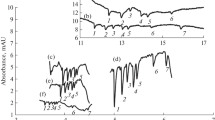Summary
It is shown that a large number of dansylamino acids can be separated on finely textured paper (Whatman No. 20) if partition chromatography and salting-out chromatography are combined. Partition chromatography (1st dimension) takes place in strongly ammoniacal atmosphere, using a solvent [11] such as it is usually employed for the separation of dinitrophenylamino acids [11, 22]. The separation of dansylamino acids by salting-out chromatography (2nd dimension) requires the use of relatively strong concentrated aqueous salt solutions. Among the salts that were investigated sodium acetate appears to be the most efficient. When surface-active agents are added to the mobile phases used for the development of the chromatogram (normal primary octyl alcohol in the 1st dimension and sodium dodecylsulphate in the 2nd dimension), better results can be obtained: the reproducibility of the separations is better (1st dimension) and the spots are smaller (2nd dimension). The optimum quantity of each dansylamino acid to be used is 6 nanomoles.
Zusammenfassung
Es wird gezeigt, daß eine große Anzahl von Dansylaminosäuren auf feinkörnigem Papier (Whatman No. 20) getrennt werden kann, wenn man Verteilungs-Chromatographie und Aussalzungs-Chromatographie kombiniert. Die Verteilungs-Chromatographie (1. Dimension) geschieht in stark ammoniakhaltiger Atmosphäre mit Hilfe eines Lösungsmittels [11], wie es üblicherweise für die Trennung der Dinitrophenylaminosäuren verwendet wird [11, 22]. Die Trennung der Dansylaminosäuren durch Aussalzungs-Chromatographie (2. Dimension) macht die Verwendung von relativ stark konzentrierten wäßrigen Salzlösungen erforderlich. Von den untersuchten Salzen hat das Natriumacetat anscheinend die günstigste Wirkung. Durch Beimengung oberflächenaktiver Zusätze zu den für die Entwicklung des Chromatogramms verwendenten mobilen Phasen (primärer n-Octylalkolhol in der 1. Dimension und Natriumdodecylsulfat in der 2. Dimension) lassen sich die Ergebnisse verbessern: bessere Reproduzierbarkeit der Trennung (1. Dimension), kleinere Flecken (2. Dimension). Die optimale einzusetzende Menge jeder Dansylaminosäure beträgt 6 Nanomol.
Résumé
Il est montré qu'un grand nombre de Dansylaminoacides peuvent être séoarés, sur papier à texture fine (Whatman no 20), si on couple une chromatographie de partage et une chromatographie de relargage. La chromatographie de partage (1ère direction) est faite, en atmosphère fortement ammoniacale à l'aide d'un solvant [11] habituellement employé pour la séparation des dinitrophénylaminoacides [11, 22]. La séparation des dansylaminoacides, par chromatographie de relargage (2ème direction), exige l'emploi de solutions salines aqueuses relativement concentrées. Parmi les sels étudiés, l'acétate de sodium semble bien être celui dont l'action est la plus favorable. L'addition d'agents tensioactifs aux phases mobiles utilisées pour le développement du chromatogramme en 1ère direction (alcool octylique normal primaire) et en seconde direction (dodécyl sulfate de sodium) permet d'obtenir de meilleurs résultats: séparations plus reproductibles (1ère direction), taches plus petites (2ème direction). La quantité optimale de chaque dansylamino-acide à mettre en jeu est de 6 m μ moles.
Similar content being viewed by others
Références
Gray W. R., Hartley B. S., Biochem. J.89, P, 60 (1963).
Gray W. R., Methods in Enzymology,XI, 139 (1967).
Gros C., Labouesse B., European J. Biochem.7, 463 (1969).
Weber G., Biochem. J.51, 155 (1952).
Hartley B. S., Massey V., Biochim. Biophys. Acta,21, 58 (1956).
Horton H. R., Koshland D. E., Methods in Enzymology,XI, 856 (1967).
Sanger F., Biochem. J.,39, 507 (1945).
Munier R. L., Thommegay C., C. R. Ac. Sci. (Paris),268, D, 1810 (1969).
Munier R. L., Thommegay C., C. R. Ac. Sci. (Paris),268, D, 1810 (1969).
Munier R. L., Thommegay C., Drapier A. M., C. R. Ac. Sci. (Paris),268, D, 1882 (1969).
Biserte G., Osteux R., Bull. Soc. Chim. Biol.,33, 50 (1951).
Levy A. L., Nature,174, 126 (1954).
Biserte G., Holleman J. W., Holleman-Dehove J., Sautiere P., Chromatographic Reviews,2, 60 (1959), Amsterdam, Elsevier 1960.
Braunitzer G., Chem. Ber.,88, 2025 (1955).
Blackburn S., Lowther A. G., Biochem. J.,48, 126 (1951).
Phillips D. M. P., Biochem. J.,68, 35 (1958).
Pairent F. W., Williamson M. B., J. Chromatog.,4, 80 (1960).
Munier R. L., «Séparation immédiate et chromatographie — 1961», (Journěes internationales d'étude des méthodes de??.) Editions GAMS, Paris 1962, p. 189.
Munier R. L., Sarrazin G., C. R. Ac. Sci. (Paris)256, 3532 (1963).
Munier R. L., Sarrazin G., Bull. Soc. chim. France 2939 (1963).
Munier R. L., Sarrazin G., J. Chromatog.,12, 542 (1963).
Munier R. L., Sarrazin G., Bull. soc. Chim. France 2959 (1965); J. Chromatog.22, 336 et 347 (1966).
Munier R. L., Z. anal. Chem.,236, 358 (1968).
Munier R. L., Ind. Chim. Belge — 33, no spécial Journées internationales de Chimie Analytique, 108 (1968)
Munier R. L., Thommegay C., Chromatographia,3, 275 (1970).
Brenner M., Niederwieser A. etPataki G., Experientia,17, 145 (1961).
Wang K. T. etWang I. S. Y., J. Chromatog.,27, 318 (1967).
Blass J., Chromatographia,2, 178 (1969).
Hartley B. S., Massey V., Biochim. Biophys. Acta,21, 66 (1956).
Boulton A. A., Busch I. E., Biochem. J.,92, P, 11 (1964).
Deyl Z., Rosmus J., J. Chromatog.20, 514 (1965).
Cole M., Fletcher J. C., Robson A., J. Chromatog.20, 616 (1965).
Morse D., Horecker B. L., Anal. Biochem.,14, 429 (1966).
Galoyan A. A., Mesrob B. K., Holeysovsky V., J. Chromatog.24, 440 (1966).
Gros C., Bull. Soc. Chim. France 3952 (1967).
Sautiere P., Starbuck W. C., Roth C., Busch H., J. Biol. Chem.243, 5899 (1968).
Stehelin D., Duranton H., J. Chromatog.,43, 93 (1969).
Woods K. R., Wang K. T., Biochim. Biophys. Acta133, 369 (1967).
Munier R. etMacheboeuf M., Bull. Soc. Chim. Biol.,32, 192, 904 (1950).
Munier R., Bull. Soc. Chim. (France), 853 (1952).
Lederer M., Nature,165, 529 (1950).
Munier R. L., Drapier A. M. etThommegay C., Manuscrit en préparation.
Munier R. L., Faivre B. etThommegay, C., Manuscrit en préparation.
Author information
Authors and Affiliations
Additional information
“Dansyl” is the abbreviation for the 1-dimethylamino-5-naphthalenesulfonyl radical
Rights and permissions
About this article
Cite this article
Munier, R.L., Thommegay, C. & Lebreau, A. Séparation des dansylaminoacides par chromatographie bidirectionnelle sur papier à texture fine. 1ère partie — Associations de chromatographie de partage et de chromatographie de relargage. Chromatographia 5, 224–235 (1972). https://doi.org/10.1007/BF02268651
Received:
Accepted:
Issue Date:
DOI: https://doi.org/10.1007/BF02268651



